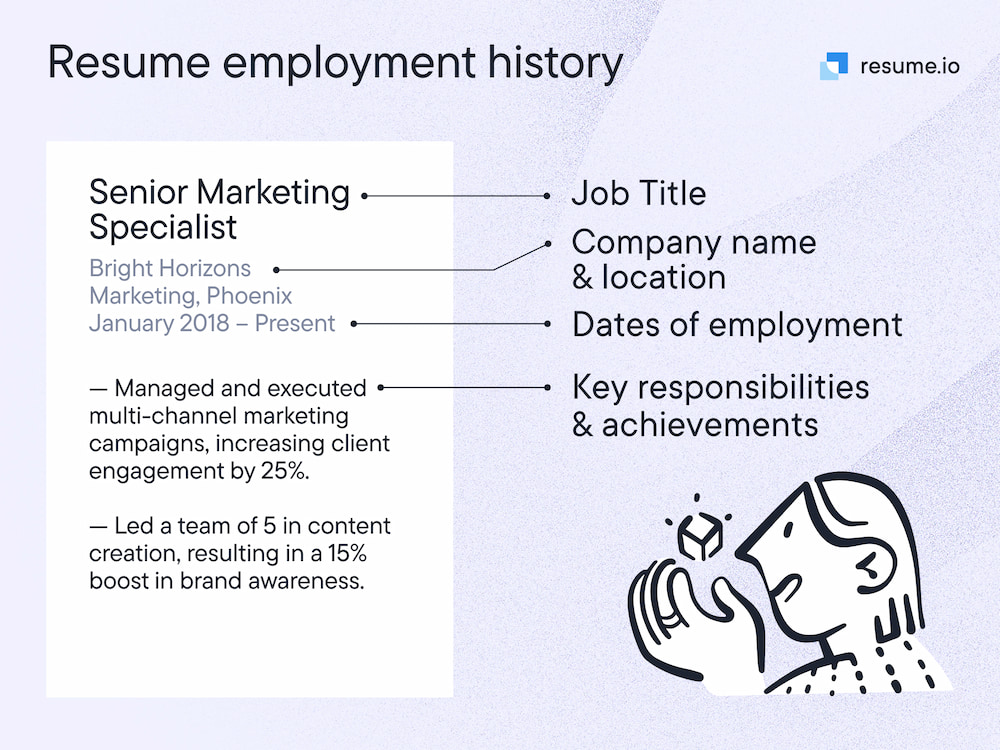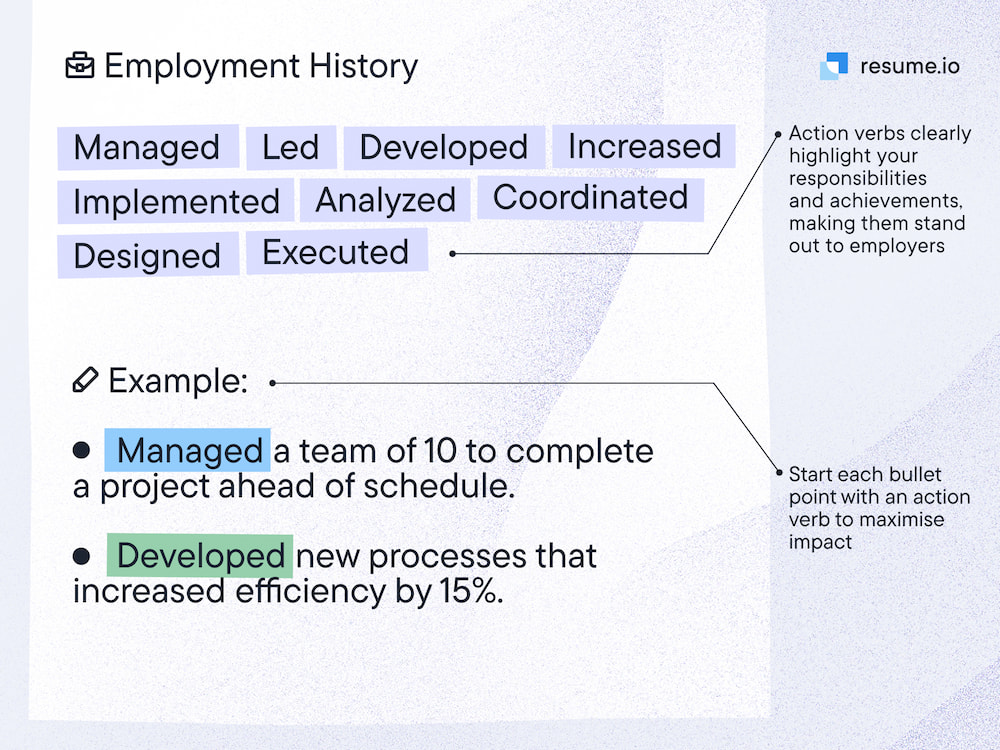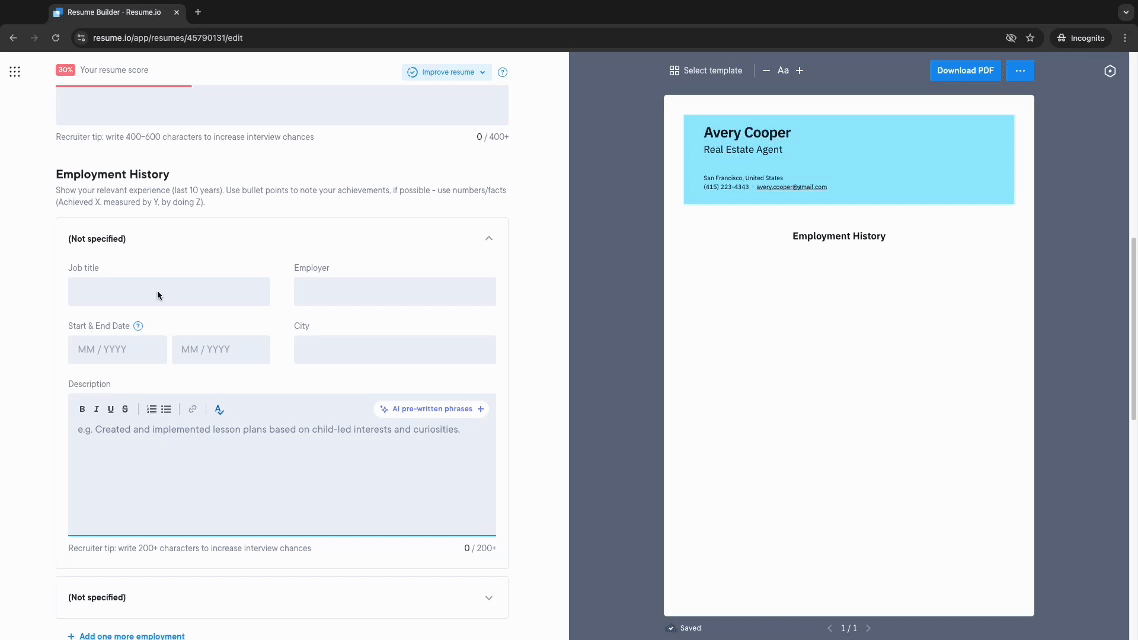How to use resume bullets like a pro with examples
When a recruiter glances at your resume, they want to cut to the chase. Present them with an impenetrable block of text and you’re unlikely to catch their attention. Your application is more likely to end up in the trash than in the “yes” tray. If you’ve got a whole lot to say — and not much space to say it — using resume bullets could be the answer for you.
There’s a certain finesse to using resume bullet points. You need to know how to make them stand out, where to use them, and what each should include. Contrary to popular belief, it’s not just about jotting down a load of information in a slick way. No, getting this right means taking the time to think about what you want each point to tell a recruiter.
Looking to get ahead? Here at Resume.io, we have all the resources you need to kickstart your career search, including writing resume example guides and helpful blog posts and a professional resume review service to sharpen your application. Regardless of where you are currently, our team of experts can help you level up and take the next step on the career ladder. Within the following guide, we will be looking at these core topics:
- Whether resumes should have bullet points or paragraphs
- Where you can include resume bullets on your application
- Expert-backed tips on how to include bullet points here
- Resume bullet examples that you can use for inspiration.
Should resumes be bullets or paragraphs?
First up, let’s answer the age-old question. A resume is a formal document so you could be forgiven for thinking you need to solely use full paragraphs. However, since resume real estate is limited, you need to do everything you can to save yourself some space.
Luckily, that’s where resume bullets come into play. Recruiters spend around seven seconds looking at each resume they review. That’s not a whole load of time to make the right first impression. Don’t waste any time. Bullet-pointing certain parts of your application will make it easy for the reader to see whether you’re the right fit for the job at hand.
When can you use bullet points on your resume?
As a golden rule, there are three core sections where you may choose to use resume bullets: your skills section, education section, and employment history section. The format allows you to quickly and succinctly share a wealth of information with the recruiter. If you include a hobbies and/or interests section, you may also want to use bullet points there.
Of course, there are some places where you should use paragraphs instead. For example, it is uncommon to use resume bullets in your personal summary. Instead, this section should be a short blurb about your professional history. In addition, you may not want to use bullet points when writing your resume header as this can all fit on one line.

When it comes to listing responsibilities, bullet points help to get to the core of each responsibility. You will have time to tell the stories that lie behind during an interview.
Tips on including bullet points on your resume
Whether you’re a natural-born wordsmith or find writing tricky, you can effortlessly use bullet points on your resume. This simple formatting approach will help you share your highest achievements with recruiters in a matter of seconds. To ensure that you get it right from the offset, you’re going to need some advice. Check out our top tips to get started.
1. Don’t use too many bullet points
Want to know how many bullets to use per job on your resume? Keep things simple. While this approach can help you showcase your achievements, you don’t want to overdo it. As a guide, you should only include between three to six bullet points below each job title.
You don’t have to bullet point every duty the job included. That can be somewhat tedious. As we have already mentioned, recruiters don’t have a whole load of time to pursue your resume. You want to keep things short and sweet. Stick to a maximum of six per role.
2. Make sure your punctuation is consistent
One of the questions that comes up time and time again is: “Should you use periods in bullet points?” The short answer is: “It depends on the type of bullet point.”
If you are writing in complete sentences, it’s generally agreed that you should end them with a period. However, if you are keeping things short and snappy, you may not need a period. Additionally, when you are doing one or two-word bullet points, you don’t need one.
Consistency is vital here. If you use periods on some bullet points and not on others, that may look messy. You don’t want to give recruiters any reason to get rid of your application. With that in mind, when you are proofreading your resume, check for any inconsistencies.
3. Focus on your results
When you’re including resume bullets in your education or work experience sections, the focus should be on achievements. One of the biggest mistakes people make is simply listing facts. For instance, you may bullet point your core job duties or the modules you covered at college. That’s all well and good, but it doesn’t tell the recruiter all that much.
Put the emphasis on your achievements. What results did you get in your exams? Did you meet (or even exceed!) your targets in your last role? You don’t have a wealth of space to spare on your resume. You need to make every bullet point count here.
4. Quantify your achievements
You’ve told the recruiter that you increased company sales — but where is your proof? When writing your resume bullets, you need to make sure that you quantify any of your achievements. You might add resume statistics (e.g. “Increased sales by 54%”) or grades (e.g. “Achieved the highest training grade in my class”). The choice is yours!
The aim is to make your resume stand out. You will be up against a whole range of smart and experienced candidates. For that reason, you need to give yourself a competitive edge. When you add some evidence to your resume, you may increase your chances.
5. Be as specific as possible
There’s no room for vagueness when it comes to your resume. If you are bullet-pointing your achievements, you need to be as specific as you can. For instance, let’s say you are talking about overseeing a remote team. You should focus on achievement - as discussed above -, but how can you make it even more relevant? Well, you can add in the type of tools you used.
You could say “Successfully managed a remote 50+ team using tools such as Asana and Slack.” The bullet point tells a recruiter two different things about you. First of all, it says you are a skilled manager. Secondly, it tells them that you can use online tools to boot.
6. Throw in some action verbs
Quit saying you were “responsible for” certain tasks. Instead, use action verbs in your resume bullets to show that you got the job done. These words include “oversaw,” “planned,” “delegated,” “managed,” “arranged,” “headed,” and “operated” to name a few.

When you’re writing your resume bullets, consider what each says to the hiring manager. The person looking at your application doesn’t simply need to know what tasks you were given. They need to know that you completed them with confidence. That is what these types of verbs say. Be clear about what you did and — in addition — the results you got.
7. Should you include your best accomplishments?
It may not be the case that you include all your top accomplishments in the bullet points. Certain accomplishments may be included in the text of the resume because you need more than a bullet point to do them justice. If the hiring manager is interested, they will read your whole resume. Share your accomplishments in the text and bullets.
It should be mentioned that numbers stand out more within bullet points. If you have a particularly impressive accomplishment with a number or percentage to back it up, put it at the start of the bullet points.

Resume bullet point examples for inspiration
Now that you’re well-versed in how to use resume bullets, you might be looking for some writing inspiration. There are different places you can use bullet points on your resume. Fortunately, we’ve got examples for the main sections where you might include them. Before you put pen to paper, take a look at these resume bullet examples for inspiration
Example #1: Skills section
When using resume bullets in your skills section, each point can be just one or two words. Recruiters are looking for well-rounded candidates. Use a mixture of both hard and soft skills for this part of your resume. See our software developer skills section example:
- Critical thinking
- PHP and Java Script
- General IT skills
- Problem solving
- Communication
- Attention to detail
- Excellent teamwork
Example #2: Employment history
Your employment section is often the shining star of your resume. If you have worked in your chosen industry for a matter of years, chances are you have a whole load of achievements you want to shout about. Rather than presenting recruiters with a block of illegible text, why not bullet-point this section? See our sales representative example:
Sales Representative, Mitchel and Marks, Dallas
May 2018 - Present
- Increased Q3 sales by 53 percent
- Successfully managed two in-house team members
- Implemented a new selling strategy and increased efficiency by 2X
- Worked with the wider team to develop new lead approaches
- Collaborated with the marketing team on upcoming campaigns
Example #3: Education section
The education section of your resume is a prime place to use bullet points. You can include information about the exams you passed, any accreditations you may have, and specific projects — so long as they are relevant to the job in question. For instance, if your GPA is above 3.4, you may want to include it as a bullet point. Here’s a quick example:
High School Diploma, Eleanor Roosevelt High School, New York
September 2012 - May 2016
- Achieved a GPA of 3.6
- National Honor Society member
Bachelor of Communications, Hunter College, New York
September 2016 - June 2019
- Honors member
- Completed 6-week work placement at MCA Advertising
- Achieved academic scholarship
Example #4: Hobbies and interests
You should only use this section if it is relevant to the job you’re applying for. If you do choose to include hobbies and interests on your resume, bullet points are the way to go.
Recruiters don’t have the time to read a paragraph about your love of playing Scrabble. However, you may want to share that you are the president of the Scrabble society and organize events for the wider team. Be selective in what you share with employers.
- President of the Birmingham Blues Society — planning annual events
- Volunteer at local food bank overseeing small team
Key takeaways
- Creating an interview-winning resume means getting straight to the point.
- Using bullet points on your resume is an easy way to save space and get your message across fast. You simply need to be confident in using them!
- It’s important to know where and when to use resume bullets. For example, you should use them below job titles and in your education section.
- Take a look at our resume bullet point examples for help getting started.






